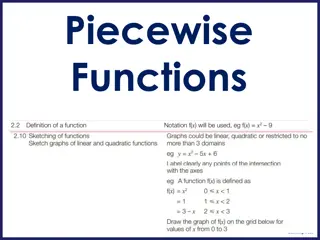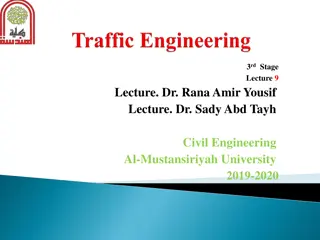Understanding Piecewise Functions: Application in Parking Garage Pricing
Explore how piecewise functions are applied in everyday situations, such as calculating parking fees based on time spent in a parking garage. Learn how to create a piecewise function by combining different equations for specific domains and graphing the function using the defined equations. See a practical example of a piecewise function for parking charges and understand the concept through tables and equations.
Download Presentation

Please find below an Image/Link to download the presentation.
The content on the website is provided AS IS for your information and personal use only. It may not be sold, licensed, or shared on other websites without obtaining consent from the author. Download presentation by click this link. If you encounter any issues during the download, it is possible that the publisher has removed the file from their server.
E N D
Presentation Transcript
Piecewise Functions Pre-Cal Advanced Ms. Ouseph
Objective for today! We will use our knowledge of domain and transformations to graph piecewise functions.
A piecewise function is A function defined by different equations on different domains.
In other words Think of it as only having a chunk of a function!
Well harp more about that later For now we will explore an everyday situation where piecewise functions are applicable.
arking Garage Suppose we were parking in a parking garage that we had to pay for by the hour. The pay structure is as follows: For the first 4 hours, it costs us $3 per hour to park. For any number of hours parked after 4 hours, it costs $2 per hour to park (These rates are proportional to any amount of time spent parked within the first three hours; for example if we only stayed for hour, we would pay $1.50.) OUR GOAL: Create a function which inputs hours parked and outputs total cost.
In groups, fill out the table below and determine an equation to calculate the total payment with respect to the hourly rate. Total Hours Parked (x) Total Payment (y or f(x)) *For the first 4 hours, it costs us $3/hour to park* f(1) = 3(1) = $3 1 2 3 4 f(2) = 3(2) = $6 f(3) = 3(3) = $9 f(4) = 3(4) = $12 y = 3x Equation 1: *For any number of hours parked after 4 hours, it costs us $2/hour to park* 5 6 7 8 x f(5) = 3(4) + 2(5-4) = $14 f(6) = 3(4) + 2(6-4) = $16 f(7) = 3(4) + 2(7-4) = $18 f(8) = 3(4) + 2(8-4) = $20 12 + 2(x 4) y = 2x + 4 Equation 2:
Equation 1: y = 3xonly works when The total number of hours parked (x) are between 0-4 0 x 4 Equation 2: y = 2x + 4only works when The total number of hours parked (x) are between greater than 4 x > 4 Combining these two, we have a piecewise function! f(x) ={ 2x + 4, x > 4 3x, 0 x 4
How do we graph a piecewise function?? Using the table we created, we can plot points on a graph to graph the piecewise function! y = 3x, 0 x 4 y = 2x + 4, x > 4 x y x y 0 1 2 3 4 4 5 6 7 8 12 14 16 18 20 0 3 6 9 Open Closed 12
Each function must live in its own neighborhood Let's put up a fence to separate these two neighborhoods. x = 4 y = 3x lives here! y = 2x + 4 lives here! Note: Its OK for each neighborhoo d to lie on the fence. They just can t cross over it!
Parking Hours vs. Payment Both equations are on the fence, but one point (from y=3x) is closed while the other (from y=2x+4) is open! f(x) ={ 2x + 4, x > 4 3x, 0 x 4 Total Payment (0, 0) (1, 3) (2, 6) (3, 9) (4, 12) (4, 12) (5, 14) (6, 16) (7, 18) (8, 20) Total Hours Parked
This analysis is not meant to explain the parking situation mathematically. Rather, it is meant to explain the idea of a piecewise function by showing you where one exists in real life. Now, we will be exploring and graphing other piecewise functions involving an array of functions (linear, quadratic, etc.)!
What do we need to know in order to graph these pieces? Fence, Domain, Points, Open/Closed, etc
Closed Open x y x y 1 2 3 4 3 2 1 0 1 0 -1 -2 5 3 1 -1
Now lets use these table of values to graph our piecewise function! x y x y 1 0 -1 -2 5 3 1 -1 1 2 3 4 3 2 1 0 Domain: (- , ) Range: (- , 5]
Lets look at a quadratic piecewise function! Work with a partner to graph the following function:
x y x y Open ( ) 0 -1 -2 -3 0 1 2 3 1 2 3 4 ( ) Closed 3 2 -1 -6
Now lets use these table of values to graph our piecewise function! x y x y 0 -1 -2 -3 3 2 -1 -6 0 1 2 3 1 2 3 4 Domain: (- , ) Range: (- , )
In summary The key to graphing piecewise functions is: Determining the fence This fence will tell you where each piece of the function lives Domain Once you know the domain of each function, its just a matter of creating a table of values to plot points!
Now that we have explored various piecewise functions, you will be given time to finish the rest of your worksheet.























